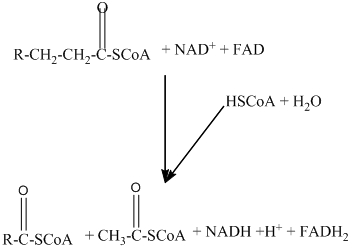
Concept explainers
(a)
Interpretation:
The number of acetyl CoA is formed from complete beta-oxidation of the fatty acid depicted in the ball and stick model, needs to be identified.
Concept Introduction:
Beta − oxidation of fatty acids involves four series of reactions. In this reaction, the long-chain fatty acid is degraded into many two-carbon unit's acetyl CoA.

The number of acetyl CoA molecules formed, and the number of times the beta-oxidation occurs can be determined by using the number of carbon atoms present in the fatty acid.
(b)
Interpretation:
The number of cycles of beta-oxidation is required for complete oxidation needs to be identified.
Concept Introduction:
Beta − oxidation of fatty acids involves four series of reactions. In this reaction, the long-chain fatty acid is degraded into many two-carbon unit's acetyl CoA.

The number of acetyl CoA molecules formed, and the number of the time beta-oxidation occurs can be determined by using the number of carbon atoms present in the fatty acid.
Want to see the full answer?
Check out a sample textbook solution
Chapter 24 Solutions
EBK GENERAL, ORGANIC, & BIOLOGICAL CHEM
- 1. What are the products of beta oxidation of a 21-carbon fatty acid? (Provide the number of each product formed.)arrow_forwardWhy is Omega 3 fatty acids essential?arrow_forward19-46 In a dietary context, classify each of the following fatty acids as an essential fatty acid or as a nonessential fatty acid. a. Stearic acid (18:0) b. Linolenic acid (18:3) c. Oleic acid (18:1) d. Arachidic acid (20:0) 10 /7 Earrow_forward
- Which of the following are saponifiable lipids? a) triacylglycerols; f) stepoids; b) prostaglandins; g) glycolipids; c) waxes; h) terpenes; d) leukotrienes; i) phosphoglycerides; e) sphyngolipids; k) plasmalogens?arrow_forwardWhich of the following are saponifiable lipids? a) triacylglycerols; f) stepoids; b) prostaglandins; g) glycolipids; c) waxes; h) terpenes; d) leukotrienes; i) phosphoglycerides; e) sphyngolipids; k) plasmalogens? Write the equation showing triacylglycerol formation from 1 mol of glycerol and 1 mol each of oleic, stearic and palmitic acids. Write the equation for the acid-catalyzed hydrolysis of the triacylglycerol: Write the equation for the saponification of the triacylglycerol: Write the equation for the hydrogenation of the triacylglycerol: Write the structure of the phosphoglyceride formed from 1 mol each of glycerol, stearic and palmitic acids, phosphoric acid, and choline . Show the formation of the sphingolipid containing oleic acid, phosphoric acid,…arrow_forwardHow many of each of these molecules are produced in the complete beta-oxidation of one 22-carbon fatty acid molecule? acetyl-CoA molecules: NADH molecules: FADH, molecules: + TOOLS x10arrow_forward
- Stearic acid is the common name for the C18 straight-chain, saturated fatty acid. Draw the structure of the fatty acyl-CoA that this forms (you don't have to draw out all of the atoms in coenzyme A; you can represent it as S-, and then show all of the reactions). Draw & identify all of the compounds formed when the eighteen carbon fat is converted to two molecules of acetyl-CoA and the fourteen-carbon fat via two turns of the fatty acid spiral. List the enzymes and coenzymes that are part of the pathway.arrow_forwardIn a dietary context, classify each of the following fatty acids as an essential fatty acid or as a nonessential fatty acid. a. Lauric acid (12:0) b. Linoleic acid (18:2) c. Myristic acid (14:0) d. Palmitoleic acid (16:1)arrow_forward
 Introduction to General, Organic and BiochemistryChemistryISBN:9781285869759Author:Frederick A. Bettelheim, William H. Brown, Mary K. Campbell, Shawn O. Farrell, Omar TorresPublisher:Cengage Learning
Introduction to General, Organic and BiochemistryChemistryISBN:9781285869759Author:Frederick A. Bettelheim, William H. Brown, Mary K. Campbell, Shawn O. Farrell, Omar TorresPublisher:Cengage Learning Organic And Biological ChemistryChemistryISBN:9781305081079Author:STOKER, H. Stephen (howard Stephen)Publisher:Cengage Learning,
Organic And Biological ChemistryChemistryISBN:9781305081079Author:STOKER, H. Stephen (howard Stephen)Publisher:Cengage Learning, General, Organic, and Biological ChemistryChemistryISBN:9781285853918Author:H. Stephen StokerPublisher:Cengage Learning
General, Organic, and Biological ChemistryChemistryISBN:9781285853918Author:H. Stephen StokerPublisher:Cengage Learning Chemistry for Today: General, Organic, and Bioche...ChemistryISBN:9781305960060Author:Spencer L. Seager, Michael R. Slabaugh, Maren S. HansenPublisher:Cengage Learning
Chemistry for Today: General, Organic, and Bioche...ChemistryISBN:9781305960060Author:Spencer L. Seager, Michael R. Slabaugh, Maren S. HansenPublisher:Cengage Learning



